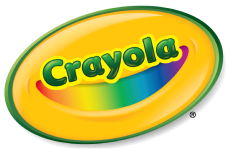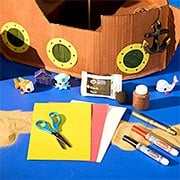La moglie del fondatore della nostra azienda, Alice (Stead) Binney, ha coniato il nome CRAYOLA Crayons. Il nome deriva da "craie", la parola francese per gesso, e "ola" da oleaginous. Questo è il nostro marchio di fabbrica dal 1903, anno di fondazione della nostra azienda, e rimane uno dei pezzi più importanti del nostro patrimonio. La prima scatola di Crayola Crayons fu prodotta nel 1903 come scatola da 8 pezzi. Veniva venduto per un nichelino e conteneva i colori rosso, arancione, giallo, verde, blu, viola, marrone e nero.
If you have additional questions, we would love to hear from you! Feel free to call or text us at 1-800-CRAYOLA weekdays between 9 AM and 4 PM Eastern Time. If you would prefer to send us an email, visit our contact us page.
Domande Correlate
Esplora le risposte alle domande più frequenti, consigli utili per rimuovere le macchie e tante idee creative per sfruttare al meglio i nostri materiali artistici e le risorse gratuite.
-
Crayola® did not invent the crayon. The "modern" crayon originated in Europe, initially made from a mixture of charcoal and oil, later replaced by powdered pigments. Wax was later substituted for oil, making the sticks sturdier and easier to handle.
In 1902, Crayola Crayons were invented by Binney & Smith and first offered for sale in 1903. The trade name "Crayola" was coined by Mrs. Edwin Binney, combining "craie" (French for chalk stick) and "oleaginous" (oily).
Crayola manufactures over 3 billion crayons each year, primarily made from paraffin wax and color pigment. Learn more about Crayola's colorful history at Crayola.com.
-
As we deepen our commitment to sustainability, we're researching what programs will make the most significant impact and help us advance our sustainability goals, like our commitment to significantly reduce emissions from our business operations by 2030.
We have already taken several steps to make our products and operations more sustainable by focusing our efforts on renewable energy and packaging initiatives.
- Renewable Energy: The 20-acre solar farm on our Crayola campus in Pennsylvania provides the electricity to make 1 billion crayons, 700 million markers a year, and 120 million jars of paint.
- Plastics Reduction: In the last 10 years, we've redesigned our broad line markers to save an estimated 2 million pounds of plastic versus its previous design.
- Packaging: We make our marker Classpack packaging with 100% recycled cardboard. Starting in 2023, this packaging, along with crayon sleeves, will be made with natural cardboard instead of bleached cardboard, which will reduce C02e emissions by an estimated 100 metric tons per year.
- Carbon Footprint: Crayola, through our parent company Hallmark, joined the Science Based Target initiative, a collaboration of global nonprofit organizations, businesses, and world governments that set goals to limit global warming to not exceed 1.5°C. To achieve this, participating organizations will need to reduce carbon emissions significantly by 2030. Crayola sources raw materials locally and manufactures many crayons and markers close to where they are used, which helps reduce the carbon footprint. In fact, Crayola has reduced CO2e emissions from our company-owned facilities' direct and indirect energy sources by 82% since 2019, with investments in renewable energy, as well as efficiencies in our US manufacturing process. (Direct energy includes the gasoline, oil, natural gas, etc. used while indirect emissions are created when the energy is produced but not where it is used.)
- Reforestation: Most Crayola colored pencils are made from wood that is reforested in an 8,288 hectare pine farm in Brazil. Each year 300,000 seedlings are planted to restore the forest.
For more information on Crayola sustainability efforts, check Crayola's Sustainability Page.
-
Because Crayola® Marker components are securely sealed during the manufacturing process, we don't recommend trying to remove the marker nib and reservoir to recycle the barrel. The marker caps can be recycled at facilities that accept #5 plastic.
Green is more than just a color to us! Learn more about Crayola's sustainability initiatives.
-
Crayola-themed retail stores are located in Chandler, Arizona; Easton, Pennsylvania; Kansas City, Missouri; Minneapolis, Minnesota; Orlando, Florida; and Plano, Texas. Five of these stores are in our Crayola Experience attractions. Admission to the Crayola Experience is not required for shopping at the Crayola Store. The Kansas City store is under the ownership and operation of our parent company, Hallmark Cards Inc. For information about hours of operation and other details, please contact your nearest store.
- Crayola Store in Easton, PA: 610-515-8000
- Crayola Store in Kansas City, MO: 816-274-7500
- Crayola Store in Minneapolis, MN: 952-851-5800
- Crayola Store in Orlando, FL: 407-757-1700
- Crayola Store in Plano, TX: 469-642-2901
To explore our vibrant array of products, visit Crayola.com.
-
Get the best results with these tips for cleaning your Scribble Scrubbie Pets.
Scrub Under Running Water:
- Gently scrub your pet under running water after play. Use the scrub brush to help release the marker inks from the tiny fibers (flocking). Do not clean your Scribble Scrubbie Pets in the dishwasher or bathtub.
Allow to Dry:
- Allow your pets to dry before a second use. Coloring on damp pets can cause the ink to wick under the fibers, making the color harder to rinse away. Let your pet air dry before storing it.
Soaking for Stubborn Stains:
- If colors persist after scrubbing under running water or have been on your pet for several days, consider soaking it in water for 20 minutes. For stubborn stains, an overnight soak may be necessary.
Additional Tips:
- Fresh coloring is easier to clean. Soap has little effect on cleaning your pets. Fresh coloring typically requires a rinse under the faucet, while concentrated coloring may require light scrubbing under a faucet or an overnight soak.
Explore Our Collection:
- Check out our entire collection of Scribble Scrubbie Pet products at Crayola.com.

